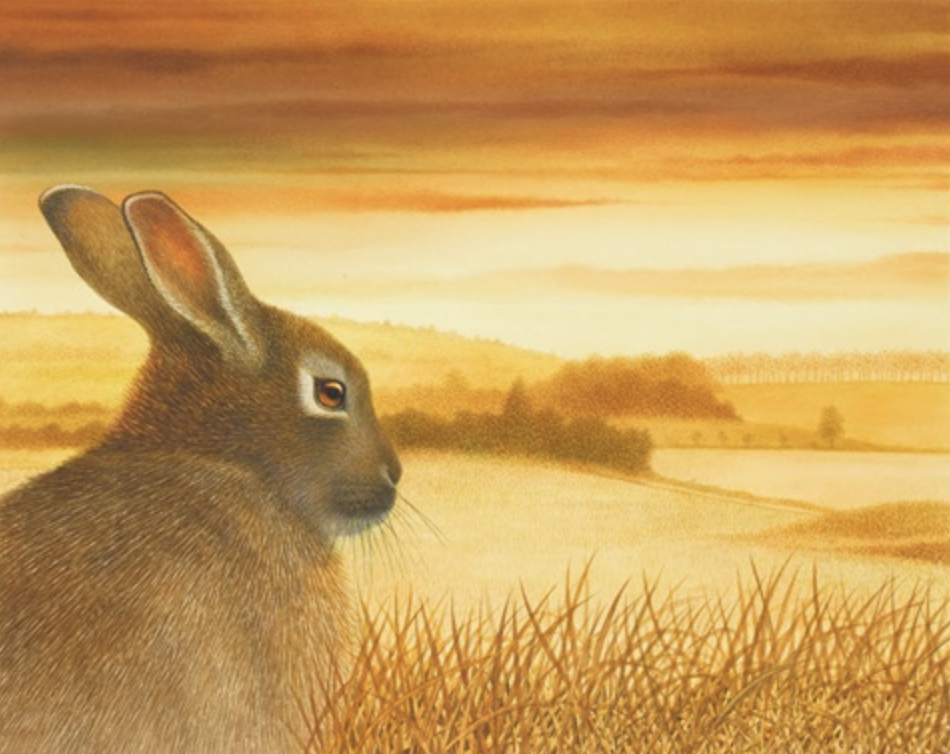
The story of the moon rabbit crosses the globe. I first discovered the rabbit in the Buddhist Jataka tales. Later I found the moon rabbit is celebrated across the Asian cultures. And then found versions of the story in indigenous American folktales. No one has brought the myth so personally to me as the artist Lisa Laughy. Lisa and I are friends going back to days in Bethlehem, NH where she lived and I visited. Both of us were creators, she an artist and writer. I was trying to write a novel. We shared our work with each other. I loved the depth of her art and the way she could talk about it. She had a deep connection with the animals she lived with, her beloved dog, a soulful doberman pinscher, and her chickens who were named. She spoke softly to the animals and I felt a solace that she must have offered them.
Years have gone by since the Bethlehem days. She has a business now, Ninth Wave Designs that features the work she does as a master wood carver. She creates Celtic designs, many inspired by early medieval Irish manuscripts, and also symbols and myths of animals native to New Hampshire
Very recently we talked about her image of the rabbit in the moon. I wondered what inspired her image because it was so important to me. We talked about the rabbit and much more. She helped me begin to imagine the well that her art comes from. She turns her own creative process into story. And the story is universal.
“When the moon was full,” Lisa remembered, “I could look up and see that rabbit. I was never alone. I must have heard the Native American story. ‘Can you see the rabbit?’ I remember the question. I was 6 or 7 or 8. It was reassuring, it’s constancy.
When she 10, she read Watership Down by Richard Adams, the epic novel of a band of rabbits in the wild who have their own language and mythology. She liked to copy the illustrator’s, Eric Tenney’s, style of rabbit that appeared on the cover of the paperback edition.

Lisa said, “The rabbit crept into my artwork. Sometimes it’s tilted this way or that way. It’s this grounding thing to me still.”
“This version I created of the rabbit in the moon was spontaneous. It’s water color with acrylic ink. Put water color down and it moves. Acrylic makes it solid.”
What about the symbols on the painting? Were they words? Yes. Lisa had started working with an alphabet she found in an old book of alchemy from the Middle Ages. “Later I invented a runic alphabet. I wanted to use a language nobody understood so that they could make their own meaning. They could project their own inner subconscious rather than, this is what I told them it is.” But on social media people have responded a lot to her alphabet. They recognize the letters. “So there is something archetypal there. There’s a commonality.”
Later, Lisa created a new site called Tail of the Bear: the Tarot Card Artwork of Lisa Laughy.
Here, images and words are “on big archetypal themes that influence your soul life.”
She writes on Tail of the Bear, “The discovery of turning over a randomly selected card to reveal a symbolic image is a unique experience filled with the potential for self-reflection.”
“It turns out, then,” she writes about the images of the tarot, “that this is a creation story, and it starts with: ‘In the beginning there was anxiety . . .’ But happily, it doesn’t end that way.”
“You ’elp a mouse. One time a mouse ’elp you. You want ’im ’e come.”
says a mouse in Watership Down who just saved a warren of rabbits
“I wanted the Tail of the Bear site to be an illustrated story book at it’s heart and it sounds like you felt that way, too.”
I did.
“I think I assume,” Lisa said, “whatever experience I have with my artwork will be what I want it to mean. To me, the rabbit in the moon is about my experience with it as a small child. When I was twelve, my father died. His absence left a void.” The rabbit in the moon was a constancy.
Lisa made her first painting when she was five, a robin catching a worm. The natural world has inspired her art ever since. “It is the greatest of privileges,” she said, “when you find someone who understands the story you are telling, whether that story is told visually or in writing, and to have them recognize it as their own.”
See Lisa’s art work on Instagram @tailofabear and @ninthwavedesign
